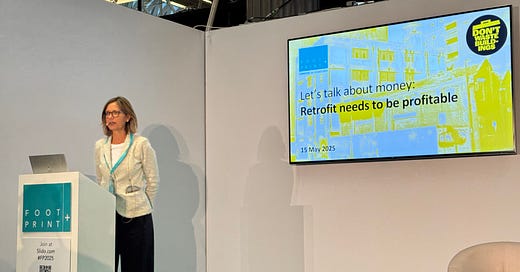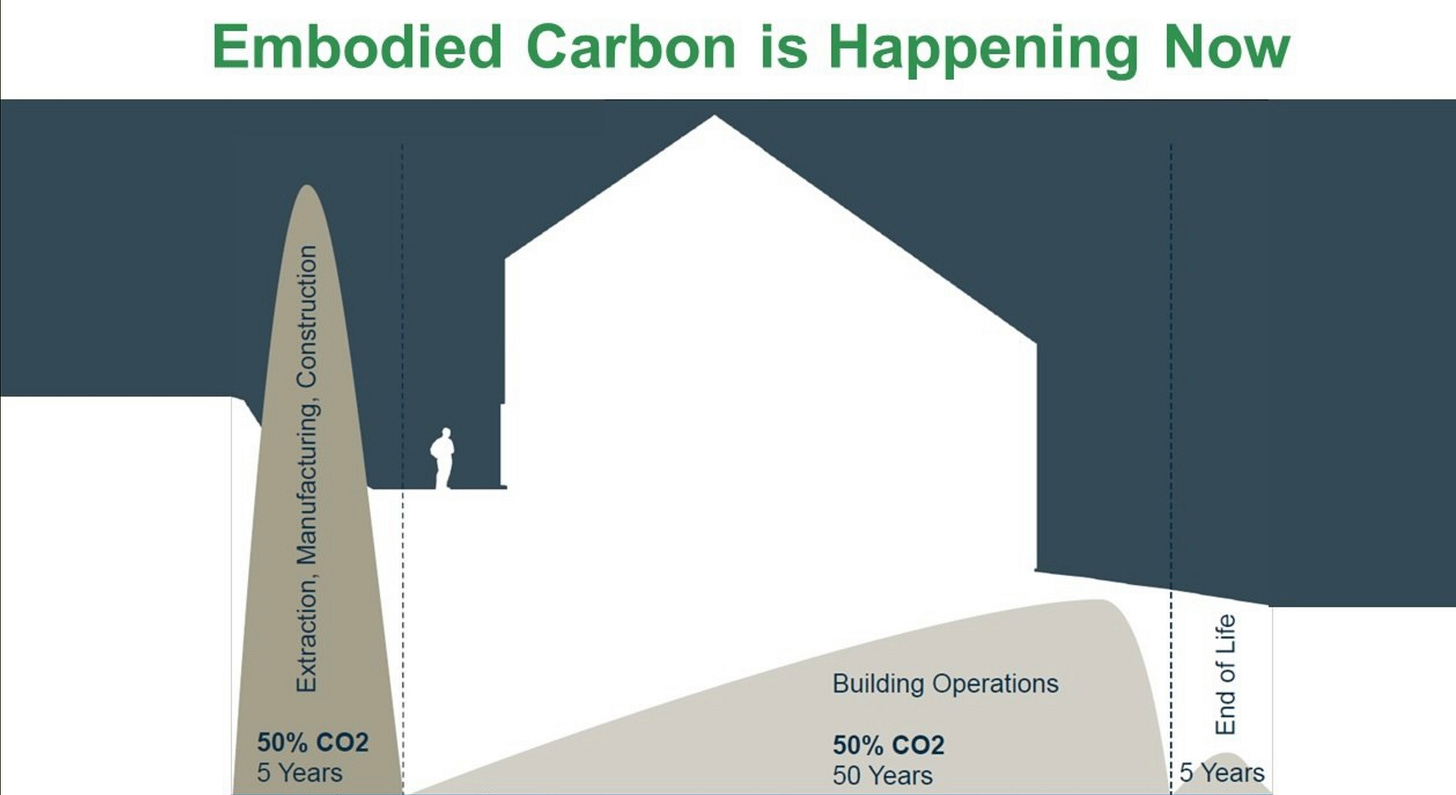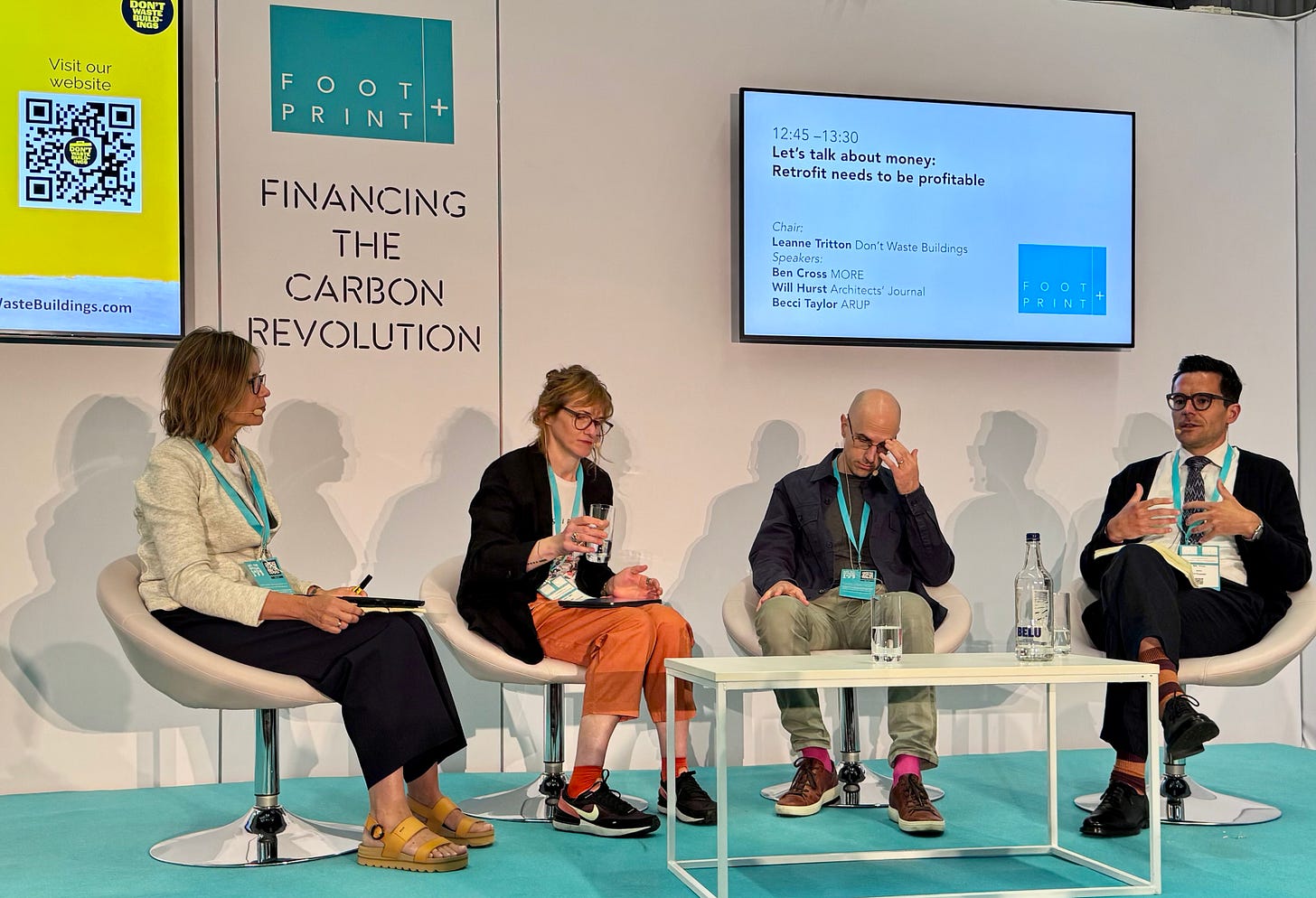Don’t Waste Buildings writes the hymn book for building preservation and retrofit
We have empty buildings and stores during a housing crisis. Maybe we should be singing a different tune.
FOOTPRINT+ is “the UK's leading annual conference dedicated to the decarbonisation of the built environment.” It attracts a lot of corporate types including developers, funders, architects, engineers, with booths from more companies in the sustainability space that I knew existed. It was not without its aggravations; there were often three or four concurrent lectures and I would have to pick one; for example, I wanted to see Joe Jack Williams talking responsible timber, but Will Hurst and Leanne Tritton were talking about money: Retrofit needs to be profitable. I went for the money instead of the timber.
Tritton and Will Hurst are co-founders, along with Richard Nelson, of Don’t Waste Buildings, “the voluntary effort to put a spotlight on up-front, or embodied, carbon and make the case for the productive use of empty and underperforming buildings.” The British do this so well, founding groups like Architects Declare, Architects Climate Action Network, and now DWB, “run by a collection of individuals made up of leading property developers, financiers, architects, engineers, heritage experts, and others.” Their somewhat niche-sounding key objectives:
“Policy clarity and financial incentives to make the reuse of existing buildings simpler and more profitable in order to stimulate growth in the housing and development sector.“
In my years first as an architect doing heritage renovations, then on the board of The Architectural Conservancy of Ontario, and extensive writing and consulting about this subject, I have learned that when it comes to saving buildings, there are many different agendas, different approaches, and different tunes. What is so interesting about DWB is their intent to demonstrate that the industry is aligned on issues of reducing upfront carbon emissions by reusing, restoring and adapting existing buildings.
“While some buildings should be demolished, or partially demolished, we now know this approach not only causes noise and disruption for communities, but also it is fuelling the climate crisis because of the sizeable upfront carbon emissions caused by demolition and replacement (new build) construction.”
DWB produced this great image and writes, “The staggering statistic is that 50% of lifetime GHG (CO2) emissions of buildings are expended before they are even occupied and in use.” But this understates the problem, which they allude to in the title: the Upfront (my preferred term) emissions are happening now, when they matter most as we try to stay under that carbon budget ceiling. You can pick a temperature, 1.5, 2 or 5 degrees, but they don’t matter; what does matter is every kilogram of greenhouse gas added to the atmosphere adds to the crisis, and that big burp at the beginning of building matters more than the operating emissions down the road.
It’s also way more than 50%; as our new buildings get more efficient, our energy supply decarbonizes, and heat pumps proliferate, it will approach 100%.
I am beginning to think we should replace the terms embodied or upfront emissions and operating emissions to NOW emissions and LATER emissions. We have to make it simple, comprehensible and offer a pathway that everyone can understand. And we all have to sing from the same hymn sheet.
Don’t Waste Buildings has written that new hymn sheet, describing the problem of underutilized buildings and empty store while we have a housing crisis. The answer:
“In most cases, threatened buildings can be restored, repurposed, revitalised. They can be adapted for new uses and, where they are unpopular or viewed as ugly, they can be made attractive, helping to restore vitality to our High Streets and local neighbourhoods.”
The hymn sheet suggests six ways Don’t Waste Buildings can help, most of which are relevant anywhere, including Retrofit:
“We will demonstrate the case for re-purposing existing commercial buildings and empty housing as high-quality homes. We face a housing crisis as well as a climate crisis, yet, due to the environmental impact of new build, current government housebuilding targets would see England use up the entirety of its 1.5°C carbon budget on housing alone.”
In Canada, the government wants to build five million housing units, and we will never reach our climate targets if we build them new in concrete and heat them with gas. We have to fix what we have and convert what we can. We need to learn from Don’t Waste Buildings and sing together from a hymn book like theirs.
Becci Taylor of ARUP and Ben Cross, an architect turned developer, were also on the panel, but I cannot describe what they do. That’s because by the end of the Footprint+ conference I concluded that this format doesn’t work- Leanne Tritton does a short presentation and the panel ends up talking for half an hour. I was in too many sessions where there was too much talk and too little presentation.
Will Hurst is managing editor of the British magazine Architects Journal, and has been a thought leader in the retrofit sector with his Retrofirst campaign. I wrote about it on Treehugger and it’s still there. RetroFirst Campaign Calls to End the Construction Industry's 'Dirty Little Secret'







Thank you for the coverage Lloyd, much appreciated! Just to clarify, we did not produce the image in the middle ("Embodied carbon is happening now"), but we borrowed it from our friends at OneClickLCA, https://oneclicklca.com/en/resources/articles/embodied-carbon-vs-operational-carbon. Very sorry about that! Many thanks, Richard Nelson, Co-Founder, DWB
Living in Moscow in the late 1990s, I was amazed at how many of the buildings predated the 1917 revolution. Historical preservation, however, meant saving the facade and replacing everything else. Manhattan also has large numbers and even neighborhoods of century or more older buildings still in use. Meanwhile my Arlington County, Virginia neighborhood is replacing 75 year old brick ramblers with $1 to $2 million McMansions. We are seeing a few more vacant office buildings being proposed for conversion to residential purposes but that may involve significant interior demolition and end up as upper tier housing.